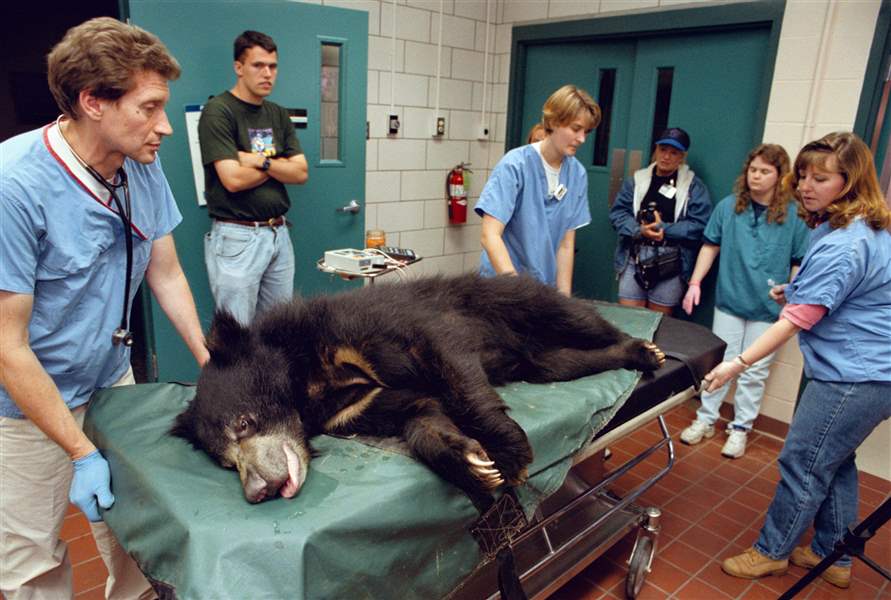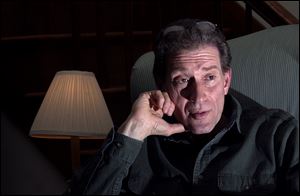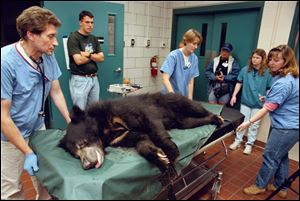
Toledo Zoo veterinarian blames firing on his warnings to USDA
But officials deny cause related to 2004 report
3/8/2005
Toledo Zoo veterinarian Tim Reichard, left, pushes a sloth bear on a gurney after an exam in 1997. Vet technician Kari Wildeboer, center, and veterinarian Wynona Shellebarger help.
THE BLADE
Buy This Image

Dr. Tim Reichard speaks about his recent fi ring from the Toledo Zoo in his South Toledo home. Dr. Reichard was dismissed from his veterinary post on Feb. 28 after 22 years of service.
The veterinarian fired from the Toledo Zoo last week said his slide from grace began when he spoke frankly to federal officials in 2004 during a routine annual animal-care inspection.
Tim Reichard was dismissed on Feb. 28 from his $75,000-a-year position after 22 years of service. The dismissal followed a yearlong struggle between Dr. Reichard and zoo administrators.
Zoo officials yesterday maintained the veterinarian's dismissal was entirely unrelated to the 2004 U.S. Department of Agriculture inspection, or to any animal-care issues. A year ago, USDA inspectors found the zoo failed to heed warnings from Dr. Reichard about animal care.
"The termination was a result of our concerns over Dr. Reichard's administrative and management skills that we had worked with him to address over the last several years," said William Dennler, the zoo's executive director, in a prepared statement. Dr. Reichard managed a staff of eight full-time and part-time employees in the animal health and nutrition department.
In an interview yesterday, Mr. Dennler acknowledged he did have a problem with the way Dr. Reichard dealt with the USDA in the past, "but that was not the factor in this termination. The predominant factor was his administrative and management skills."
Mr. Dennler, in fact, praised Dr. Reichard's animal-care skills. "There is no question in my mind that he raised the level of animal care here at the zoo."
But until February of 2004, Dr. Reichard said, there were no signs that zoo management was unhappy with him in any capacity. His annual performance reviews were all well above average, and Robert Harden, the zoo's chief operating officer, who was Dr. Reichard's immediate supervisor, wrote in a glowing review dated Dec. 12, 2003, that the vet was "well liked and respected throughout the zoo."
Two months later, everything changed with the release of the February, 2004, USDA inspection report. The report cited six areas the zoo needed to improve. Among those findings were a number having to do with Dr. Reichard.
The USDA - the federal agency that licenses zoos and other animal-care institutions - found the Toledo Zoo denied the vet "the appropriate authority to ensure" good animal health care. Some of these concerns revolved around the death of an elderly hippopotamus, Cupid, in July, 2003.
Cupid was found close to death late in the day. He was lying near a door to the hippo exhibit. A necropsy revealed the animal had a broken neck. Damaged neck muscle tissue indicated severe trauma. Although zoo employees initially thought the animal collapsed and somehow injured its neck in the fall, or hurt itself by its own thrashing, Dr. Reichard said he came to believe that the animal's neck broke when its head was forced into a narrow opening by a closing concrete-and-steel hydraulic door.
He speculated that the geriatric animal, which a post-mortem exam revealed had many severe health problems, may have collapsed near the door at some point during the day. The hydraulic door is generally kept open about 1 foot so keepers can see into the exhibit. But a keeper closed the door that day so a maintenance team could work near the animal enclosure. Dr. Reichard and others theorized that the closing door may have pushed the prone animal's head into an unmovable position. The animal may have been caught between two walls of a narrow hall that serves as a keeper escape. Both walls were splashed with blood.
By the time keepers discovered the 48-year-old hippo, it was unconscious. The animal was euthanized when veterinarians determined there was no hope of reviving it.
After Cupid's death, Dr. Reichard requested that keepers check on all animals halfway through the day. The USDA report said new procedures reflecting this requirement had not been completed. In addition, the USDA report noted that modifications to prevent a repeat of the hippo accident were not made until six months after the animal's death.
The report further stated that numerous practices relating to the welfare of giraffes, each requested by Dr. Reichard, had not been carried out. The practices included the veterinarian's request that the animals be trained to receive medical treatment.
"I had been pushing for this for years," Dr. Reichard said. Immobilizing a giraffe for medical care presented "a lot of physical risk" to both the animal and the veterinary staff, he said. Once immobilized by a dart gun, an animal can fall over backward and break its neck or rupture arteries, he said.

Toledo Zoo veterinarian Tim Reichard, left, pushes a sloth bear on a gurney after an exam in 1997. Vet technician Kari Wildeboer, center, and veterinarian Wynona Shellebarger help.
"Then you have to keep its head up high. Then you have the challenge of getting [the] animal back up. And then there's the danger to the people involved," Dr. Reichard said. The veterinary staff had to work on injured giraffes in 2001, 2002, and 2003, increasing Dr. Reichard's sense of urgency in his requests for animal training. Animals with this training can, on request, walk into a chute that limits mobility, and then remain calm during treatment inside the chute.
"From the review of numerous documents and interviews, it is clear that these veterinary recommendations from the attending veterinarian [Dr. Reichard] have not been addressed in a reasonable time. The licensee [the Toledo Zoo] has failed to provide the attending veterinarian with adequate authority to ensure the provision of adequate veterinary care," the 2004 USDA report stated.
Zoo director Dennler said the protocols cited by the USDA inspector were "no big deal. Seriously. They're just - what can I say, you have different inspectors who want different things. We had an inspector that suddenly wanted different protocols in place."
Furthermore, Mr. Dennler said the zoo "got a clean bill of health from the USDA" after the agency investigated the death of Cupid the hippo, and of a giraffe that was gored by an antelope-like animal in 2001.
By late April of 2004, it was clear Dr. Reichard's star was falling. Zoo administrators announced a plan for Dr. Reichard to share his duties as "attending veterinarian" with his subordinate, veterinarian Wynona Shellebarger, and with mammal curator Randi Meyerson, who is also a veterinarian but is not licensed to practice in Ohio. The post of attending veterinarian is created by law, and the person who holds it is responsible for communications with the USDA. Ultimately, the proposal for a triumvirate of attending vets was dropped. But by August, the zoo replaced Dr. Reichard as attending veterinarian with Dr. Shellebarger.
By that time, Dr. Reichard was already on the ropes. In late April, he received what was termed a "verbal" reprimand, although it was issued in writing. It was followed by a "written" reprimand in August, in which the veterinarian was accused of steadily undermining animal curator Dr. Meyerson, poor communication skills, and intimidating other employees.
"It's like a bad movie," Dr. Reichard said yesterday afternoon. "It's unreal. I've lost a lot of my naivete."
Despite his problems in Toledo last year, Dr. Reichard is well-regarded in the national zoo veterinary community. He is active in the American Association of Zoo Veterinarians, and recently was appointed to the American Veterinary Medical Association animal welfare committee.
Ray F. Wack, president of the American Association of Zoo Veterinarians in 2001, said, "There is probably nobody in the profession I have a higher degree of respect for" than Dr. Reichard. Dr. Wack is the chief veterinarian for the Sacramento Zoo and chief of service for Zoological Medicine at the University of California Davis School of Veterinary Medicine.
"You can probably call just about any zoo vet in the country and they'll know him and speak highly of him," Dr. Wack said. "I can't think of a more well-respected, compassionate, talented person."
Dr. Reichard said the zoo tried to get him to sign a letter of resignation for more than a month, which he refused to do.
"People take a buyout, and then nothing gets out," Dr. Reichard said.
Dr. Reichard said he plans to approach the zoo's 16-member board of directors and ask them to consider his reinstatement. Although most board members contacted last night declined to comment, Board President Stephen Staelin said he would "absolutely not" consider reinstatement.
"It's really a management issue, which ... I've been aware of, and certain members of the board have been aware of the situation for several years. As far as I'm concerned, I feel very comfortable that due process has been served in this case, and believe the situation has been handled with sensitivity and fairness with respect to Dr. Reichard. He's chosen to take it into the public arena, which is unfortunate."
Zoo board members are nominated by a committee composed of the board's executives and its committee chairmen. The full board votes on each appointment.
The Toledo Zoo received $12 million of its $22 million revenue in 2003 from Lucas County property taxes.
Contact Jenni Laidman at jenni@theblade.com or 419-724-6507.